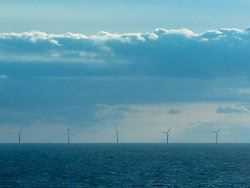Sunday, May 2nd, 2021
New project in planning
Will the Baltic 1 wind farm become the nucleus of new wheels?
The yield is good, there were no disasters: the Baltic 1 wind farm off the Baltic Sea coast of Mecklenburg-Western Pomerania met expectations. Nevertheless, not everything is good for the people on the Darß. A second, significantly larger wind farm is being planned.
The importance of a structure can sometimes be seen in who opens it: On May 2, 2011, Chancellor Angela Merkel flew over the new Baltic 1 wind farm in a helicopter and symbolically put it into operation. It was the first commercial wind farm off the German Baltic coast. Since then, the 21 wind turbines have been rotating 16 kilometers off the Fischland-Darß-Zingst peninsula and producing regenerative electricity for the operator, the EnBW energy company in Karlsruhe: “The wind yields and technical availability are above our expectations,” says EnBW spokeswoman Stefanie Klumpp .
The hubs of the wind turbines are 67 meters above the surface of the water, the huge rotors have a diameter of 93 meters. With just under 50 megawatts (MW), their output is theoretically sufficient to supply around 50,000 households with electricity. “The most profitable month was December 2015 with 594 full load hours,” says Klumpp. With Baltic 2, EnBW is now operating a second, larger wind farm northeast of Rügen.
Concerns about the fact that tourism will be damaged on the Darß because of the visible installations of Baltic 1 have not yet arisen: “I don’t know any guests who have said they will never come back because the wind farm is there,” says Prerow’s Mayor René Roloff. Also, none of the many thousands of freighters that operate on the nearby Kadetrinne has gotten out of control and has a wind turbine damaged. “But that doesn’t mean that no accident is possible in the future.”
Nevertheless, Roloff and with him many people on the peninsula are sounding the alarm. “At the time, we were assured that only a wind farm of this size is sustainable for the region. Now Baltic 1 is becoming the nucleus for a wind farm of a completely different size.”
“Only wind turbines”
Because the Gennaker wind farm is being planned in the immediate vicinity. According to the wishes of the project developer WPD, 103 wind turbines with a maximum height of 175 meters and a total output of 865 megawatts will work there in the future. When that will happen is uncertain. The shortest distance of the 175 meter high systems should be only ten kilometers from the Darß.
Since the facilities will be significantly closer and larger than those of Baltic 1, Roloff fears that the region will be more attractive. “From left to right only wind turbines.” That is a panorama that cannot be advertised. “We have to look for other motives now.”
The Naturschutzbund Deutschland (Nabu) filed an objection to the building permit in 2020. As Kim Detloff from Nabu says, the huge facilities for migratory and resting birds pose a massive risk. The protection of birds, especially the cranes on their way twice a year between Scandinavia and southern Europe, was already one of the central points in the lawsuits against Baltic 1.
Like the operator EnBW, the German Wind Energy Association has a different view of offshore development in the Baltic Sea. “At the time, Merkel spoke of the opening of a new chapter in energy generation in Germany. That was actually the case,” says association manager Wolfram Axthelm. At that time, the goal of achieving 25 gigawatts (GW) of offshore power in the North and Baltic Seas by 2030 was defined. “Today politicians are confident of 40 GW by 2040.” Offshore is highly profitable in the Baltic Sea and, thanks to the more stable conditions, can be forecast very well.
The concerns about tourism and species protection were unfounded. Axthelm states that biodiversity is even increasing in the parks because they act like artificial reefs and new biotopes are being created. Mecklenburg-Western Pomerania could not only gain importance as a landing point for clean electricity. “The country can create its own clusters for the industrial refinement of clean electricity.”
EnBW spokeswoman Klumpp refers to the rapid development of offshore wind power: The turbines of Baltic 1 have an output of 2.3 MW, the total output is almost 50 MW. “Our largest project” Hohe See “and” Albatros “, which went into operation in 2020, has turbines with a total output of 7 MW and 640 MW.” For the He Dreiht offshore wind farm, which is to be commissioned with 900 MW in 2025, 13 to 15 MW per system would be calculated.
.
